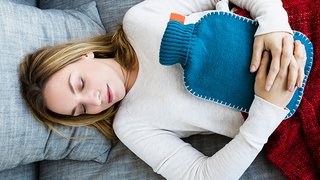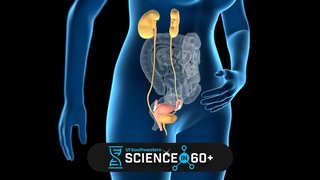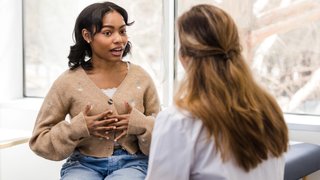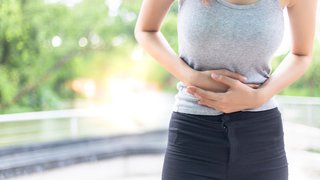Boning up on facts: Why osteoporosis mostly affects women and what can be done
April 15, 2025

As we age, it's normal to experience some bone loss as our bodies are slower to rebuild and replace broken down bone. But for a number of people, particularly women, the problem may be pathological.
The Food and Drug Administration (FDA) estimates that 10 million Americans live with osteoporosis, a disease characterized by weak and brittle bones. Instead of a dense network of healthy connective tissue, osteoporotic bones are more porous and "spongy," which heightens the risk of serious fractures – some occurring with little to no trauma or physical pressure at all.
And while anyone can be diagnosed with osteoporosis, women make up more than 80% of cases in the U.S., according to the FDA. The Bone Health and Osteoporosis Foundation predicts that 1 in 2 women will break a bone in her lifetime due to osteoporosis compared with 1 in 4 men.
One thing to consider is that women generally have lower bone mass than men to start. Their bone density wanes with the onset of menopause and tapering hormone levels. People typically reach peak bone mass in their 20s or early 30s. After that, it's just a matter of maintaining that bone density.
Estrogen plays a crucial role in this, but as women's bodies slow hormone production, they lose some of that protective effect. Research shows that there is generally a significant and accelerated reduction in bone mass during the first year of menopause. One 2023 study reported that 54% of postmenopausal women in the U.S. live with osteopenia, a less severe condition of bone weakness that precedes osteoporosis.

What factors influence bone health?
However, before you panic, keep in mind that several other factors influence individual risk. Some are beyond our control, but there are also small changes you can make that will benefit you in the long run. Here are a few risk considerations:
● Genetics and physical build – There is a genetic component to osteoporosis, and a family history does enhance the risk of disease. The flip side of this is that some women naturally have strong, dense bones that leave them less vulnerable.
● Habits and behaviors – Our bones are similar to muscles in that the more we use them, the stronger they become. Regular weight-bearing exercises will go a long way in preserving bone health. Try incorporating more exercises like jogging, hiking, walking, yoga, and Pilates into your routine. Likewise, there are also habits you should avoid – namely heavy drinking and smoking.
● Nutrition – A lack of sufficient nutrients such as calcium, vitamin D, and protein can contribute to osteopenia and osteoporosis. Because of this, certain digestive and metabolic issues and eating disorders place you at higher risk.
● Other health conditions – Thyroid disorders can disrupt normal bone remodeling and lead to bone loss. Some cancers can also put you at greater risk of osteoporosis, whether because it targets the musculoskeletal system directly or because its treatment may cause negative side effects. Therapies for breast cancer, for example, often involve reducing estrogen levels, which can lead to loss in bone density. Women – and men – with a history of kidney stones also have a higher risk of osteoporosis.
● Certain medications – Cancer therapies are not the only drugs that interfere with mineral metabolism in our bones. For example, Depo-Provera, an injectable contraceptive, also targets hormones and is associated with a dip in bone density. But this effect can be reversed when the drug is discontinued. Chronic corticosteroid use is also linked to a greater risk of bone loss, so it's recommended that women communicate with their physician if this is a concern.
When should I get screened for osteoporosis?

Your primary care provider, Ob/Gyn, and endocrinologist are on the frontlines of protecting your bone health. They are often the first ones to register major changes within your body or lab results. Much of the issue can be sussed out with a thorough medical history and lab tests: Do you have abnormal blood calcium levels? Do you have a history of fractures or thyroid issues?
But the gold standard of osteoporosis screening involves a dual-energy X-ray absorptiometry (DXA) scan, an imaging technique for measuring bone mineral density. During the process, the patient lies on a table while an imaging device scans her body. The results are distilled into numerical values that convey where on the spectrum your bone density lies. A T-score between -1 and -2.5 indicates some bone loss while a score at or below -2.5 indicates osteoporosis.
Because older women are more likely to experience osteoporosis as they age, I often advise patients to get a baseline assessment around the time of menopause, which can vary widely. In January 2025, the U.S. Preventive Services Task Force (USPSTF), an independent advisory committee, recommended screenings for women 65 and older as well as for postmenopausal women younger than 65 who have one or more risk factors.
UTSW is a hub for diagnosis, treatment, and research
Physicians who specialize in mineral metabolism treat and diagnose a range of disorders, including osteoporosis and chronic kidney disease-mineral and bone disorder (CKD-MBD), a complex syndrome associated with kidney failure that can cause serious and sometimes fatal complications.
They also work closely with the researchers at the Charles and Jane Pak Center for Mineral Metabolism and Clinical Research, which was created at UT Southwestern in 1994. Under the leadership of Orson W. Moe, M.D., the department's investigators continue to advance the clinical practice, scientific discovery, and education of mineral physiology and diseases.
The collaboration of UTSW clinicians and researchers translates to enhanced services for laboratory testing and patient care, including:
● DEXA (Dual energy X-ray absorptiometry) scans evaluate bone mineral density and calculate trabecular bone score, which is an indirect measurement of bone quality. For osteoporosis, it is used in combination with comprehensive blood and urine tests to guide potential therapies.
● RESTORE (Returning Seniors to Orthopaedic Excellence) Program provides post-op hip fracture care to geriatric patients to prevent future fractures and reduce hospital stays. Directed by Megan Sorich, D.O., Assistant Professor of Orthopaedic Surgery, this program mobilizes a coordinated effort from experts in mineral metabolism, geriatrics, orthopedics, and pain management to provide comprehensive patient care. It is the only program of its kind in North Texas.
● Genetic testing helps patients with rare genetic bone disorders.
● HR-pQCT (high-resolution peripheral quantitative computed tomography), a 3D imaging technique available to Pak Center researchers, offers another perspective on bone microarchitecture and bone mineral density. Investigators may also offer more extensive evaluations for unexplained mineral metabolism conditions.
How can I boost my bone health?
Having low bone density is not the same as osteoporosis. But if it's not taken seriously, it can eventually lead to major fractures that make it harder to live independently and often require months of physical rehabilitation. The goal is to intervene before low bone density becomes debilitating, which means being proactive. Here are some ways women can temper their risk:
Enrich your diet

Calcium, vitamin D, and protein are all important components of bone metabolism, and the best source is through diet. The National Institutes of Health Office of Dietary Supplements recommends a daily intake of about 15 micrograms (600 International Units) of vitamin D3 for children, teenagers, and adults under 70. Those who are older than 70 should aim for 20 mcg (800 International Units) of vitamin D3. And when it comes to calcium, the general guidance is for premenopausal women to take in about 1,000 milligrams (mg) each day and 1,200 mg for menopausal women, preferably from food sources.
There is no clear consensus on the amount of protein women should consume daily, but one 2023 scientific review published in Nutrients suggests that 1 to 1.2 grams of protein per kilogram of body weight – coupled with regular exercise – is ideal for women experiencing menopause if they want to maintain their weight or gain skeletal muscle mass.

Exercise regularly
Activities such as Pilates, weightlifting, and jogging or running are known to strengthen bone health. Even simply walking while carrying extra weights can make a difference. The key is to focus on resistance training, weight-bearing exercises, and muscle strengthening. Pairing these regimens with balance and posture exercises can also help reduce fall risks. If you form these habits early on, the benefits will follow you later in life.
You are more likely to keep up with a routine that fits your needs and schedule, but the International Osteoporosis Foundation recommends starting with 30-40 minutes of exercise three to four times a week.
Consider available drug therapies
Prescription medications can help preserve and even increase bone density. Bisphosphonates are a common example and often used to slow the breakdown of bones. These drugs are available as self-administered pills or by IV infusion.
It is important to note that estrogen therapy cannot restore or rebuild bone mass, but women may take estrogen during the menopause transition to maintain their bone density and prevent osteoporosis.
See a specialist and ask about additional resources
Some patients require further evaluation than a general practitioner can provide. Physicians with UTSW's Pak Center have years of expertise in treating and studying "stones and bones" disorders, including kidney stone disease and skeletal disorders.
At UTSW, we offer hard-to-find technology and services that are better equipped to assess symptoms, run clinical research studies, and develop comprehensive treatment plans for even the most severe and complicated cases. Whether you have an underlying condition that's contributing to osteoporosis or need general recommendations to prevent bone loss, our goal is to inform and empower patients to make the best decisions possible regarding their health.
- For osteoporosis screening, make an appointment with the Lowe Foundation Center for Women’s Preventative Health Care by calling at 214-645-3888.
- For osteoporosis treatment, make an appointment with the Mineral Metabolism and Clinical Research Clinic at 214-645-2870.
- To talk with an expert about osteoporosis and treatment options or see if you qualify for the RESTORE program, make an appointment by calling the Orthopaedic Surgery Clinic at 214-645-3300.











